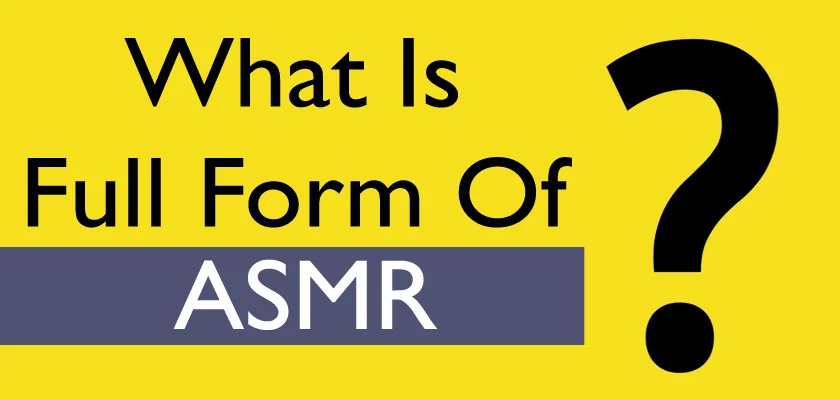Do you know what is the ASMR Full Form? The term “ASMR,” or Autonomous sensory meridian response, has been gaining popularity over the past decade. It is characterized by a tingling sensation that begins in the brain and spreads throughout the body, often triggered by specific sounds or visuals. Even though ASMR has been around for centuries, it has only recently been the subject of scientific study and understanding.
Table of Contents
What is the ASMR Full Form?
ASMR – Autonomous Sensory Meridian Response
What is ASMR?
ASMR is a sensory experience that can be triggered by a variety of stimuli, including visual, auditory, and tactile sensations. This experience is often described as a tingling feeling that starts at the top of the head and travels down the spine and into the limbs. ASMR triggers can be anything from a tapping or scratching sound to a soft whisper or gentle touch.
Understanding the Science Behind ASMR
How ASMR Works in the Brain
ASMR triggers are thought to activate the parasympathetic nervous system, which is responsible for the body’s rest and relaxation response. The sensation is believed to occur due to the release of endorphins and oxytocin, neurotransmitters that induce pleasure and happiness.
The Role of Endorphins and Dopamine in ASMR
Endorphins and dopamine are two neurochemicals that play a significant role in the experience of ASMR. Endorphins are responsible for reducing pain perception and inducing a feeling of euphoria, while dopamine plays a role in reward-motivated behavior. These hormones are released during ASMR, which may explain why individuals feel relaxed and happy after experiencing ASMR triggers.
Popular ASMR Triggers and Techniques
Whispering and Soft-Spoken ASMR
Whispering and soft-spoken ASMR are among the most popular triggers among ASMR enthusiasts. This type of ASMR involves speaking in a gentle and quiet voice, which can induce a feeling of relaxation and calmness.
Sounds and Visual ASMR Triggers
Other popular ASMR triggers include sounds and visuals, such as tapping, scratching, and visual movements. These triggers can be found in many ASMR videos and are often combined to induce a more intense tingling sensation.
Exploring the Benefits of ASMR
Relaxation and Stress Relief
ASMR has been shown to be an effective relaxation technique that can help individuals reduce stress and anxiety. The sensation can induce a calming feeling and promote a sense of well-being.
Improving Sleep and Insomnia
ASMR may also be beneficial for individuals who have difficulty sleeping or suffer from insomnia. ASMR’s relaxation and calming effects can help individuals fall asleep faster and stay asleep longer, leading to better overall sleep quality.
Here are the other benefits of ASMR:
- Induces relaxation and calmness
- Reduces stress and anxiety
- Helps improve sleep and insomnia
- Can improve mood and overall well-being
- Provides a form of sensory stimulation for individuals with sensory processing issues
- It may provide temporary relief from chronic pain.
- It can be used as a tool for mindfulness and meditation.
- It helps individuals with social anxiety feel more comfortable in social situations.
- Can provide a sense of connection and intimacy through role-play scenarios
- It provides entertainment and escapism for individuals who enjoy ASMR content.
ASMR in Popular Culture
ASMR is a sensation of tingling that starts in the scalp and moves down the neck and spine. It has become increasingly popular in recent years and has made its way into popular culture in a variety of ways.
ASMR on YouTube and other Platforms
The most popular form of ASMR is through YouTube videos, where creators use a variety of sounds and visuals to trigger the response. These videos often involve whispering, tapping, and crinkling sounds and role-play scenarios like haircuts, massages, and makeup tutorials.
Other platforms like TikTok and Instagram have also seen an increase in ASMR content, with creators using short-form videos to showcase their sensory experiences.
Criticisms and Misconceptions Surrounding ASMR
Despite its growing popularity, ASMR has faced criticisms and misconceptions surrounding its validity and safety.
Scientific Controversies
Limited scientific research on ASMR leads to debates among experts about its authenticity and classification as a medical condition. Some argue it is a legitimate response with potential therapeutic benefits, while others believe it is simply a placebo effect or a form of attention-seeking behavior.
Tips for Trying ASMR at Home
If you’re interested in experiencing ASMR for yourself, you can do a few things to create a comfortable and relaxing environment.
Creating the Right Environment
Find a quiet, comfortable space where you won’t be interrupted or distracted. Use headphones to enhance the binaural sounds often used in ASMR videos.
Exploring Different Types of ASMR
Experiment with different types of ASMR triggers, including tapping, scratching, whispering sounds, and visual triggers like hand movements and light patterns.

Other ASMR Full Forms
If you want to know more about other full forms of ASMR Word, see the table below:
| Term | Full Form | Category |
| ASMR | Autonomous sensory meridian response | Entertainment |
| ASMR | Amélioration du Service Médical Rendu | Medical |
| ASMR | Australian Society for Medical Research | Association |
| ASMR | American Society of Mining and Reclamation | Organization |
FAQs- What Is The ASMR Full Form?
What does ASMR stand for?
Autonomous Sensory Meridian Response
What is ASMR?
A tingling, calming sensation felt in response to certain sounds, visuals, or tactile experiences.
What are common ASMR triggers?
Whispering, tapping, crinkling, scraping, personal attention sounds, slow movements, etc.
What are the benefits of ASMR?
Relaxation, stress reduction, improved sleep, mood enhancement, and pain relief (anecdotal reports).
Who experiences ASMR?
Estimates suggest around 20% of the population experiences ASMR, although everyone reacts differently.
Is ASMR a sign of a mental health condition?
No, ASMR is not a recognized mental illness.
Is ASMR addictive?
While some may find ASMR highly enjoyable, there is no evidence of addictive behavior associated with it.
Is all ASMR content sexually suggestive?
No, while some ASMR content can be sexually suggestive, a vast majority is not.
Where can I find ASMR content?
YouTube, podcasts, apps, and dedicated ASMR websites offer various triggers.
What tips do you have for experiencing ASMR?
Use headphones, find triggers that resonate with you, create a relaxing environment, and be open to experimenting.
Is it okay to create ASMR content myself?
Absolutely! Consider what triggers you enjoy and ethically create content that adheres to community guidelines.
Thanks for reading What is the ASMR Full Form? Bookmark our website Whatisfullform.com to know or read our collection of full forms.


